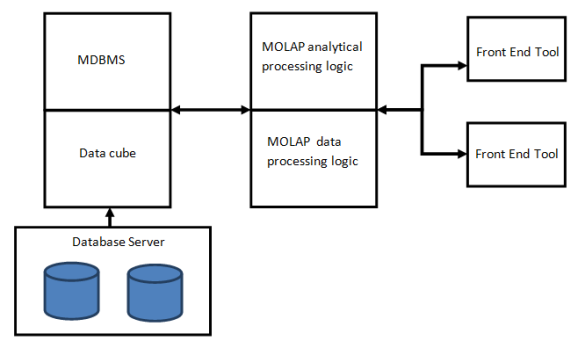Multidimensional online analytical processing (MOLAP) extends OLAP functionality to multidimensional database management systems (MDBMSs). (An MDBMS uses special proprietary techniques to store data in matrix like n- dimensional arrays.) MOLAP’s premise is that multidimensional databases are best suited to manage, store, and analyze multidimensional data. Most of the proprietary techniques used in MDBMSs are derived from engineering fields such as computer- aided design/computer-aided manufacturing (CAD/CAM) and geographic information systems (GlS).
Conceptually, MDBMS end users visualize the stored data as a three- dimensional cube_ known as a data cube. The location of each data value in the data cube is a function of the x, y, and z axes in a three-dimensional space. The x, y, and z axes represent the dimensions of the data value. The data cubes can grow to n-number of dimensions, thus becoming hyper cubes.
Data cubes are created by extracting data from the operational databases or from the data warehouse. One important characteristic of data cubes is that they are static; that is, they are not subject to change and must be created before they can be used. In other words, data cubes cannot be created by ad hoc queries. Instead, you query pre-created cubes with defined axes; for example a cube for sales will have the product, location, and time dimensions, and you will only be able to query those dimensions.
Therefore, the data cube creation process is critical and requires in-depth front-end design work. This front end design work may be well justified by the fact that MOLAP databases are known to be much faster than their ROLAP counterparts, especially when dealing with small to medium data sets: In order to speed data access, data cubes are normally held in memory, in what is called the cube cache. Because MOLAP also benefits from a client/server infrastructure, the cube cache can be located at the MOLAP server at the MOLAP client, or in both locations. Figure shows the basic MOLAP architecture.

Advantages:-
- Excellent performance: MOLAP cubes are built for fast data retrieval, and is optimal for slicing and dicing operations.
- Can perform complex calculations: All calculations have been pre-generated when the cube is created. Hence, complex calculations are not only doable, but they return quickly.
Disadvantages:-
- Limited in the amount of data it can handle: Because all calculations are performed when the cube is built, it is not possible to include a large amount of data in the cube itself. This is not to say that the data in the cube cannot be derived from a large amount of data. Indeed, this is possible. But in this case, only summary-level information will be included in the cube itself.
- Requires additional investment: Cube technology are often proprietary and do not already exist in the organization. Therefore, to adopt MOLAP technology, chances are additional investments in human and capital resources are needed.
